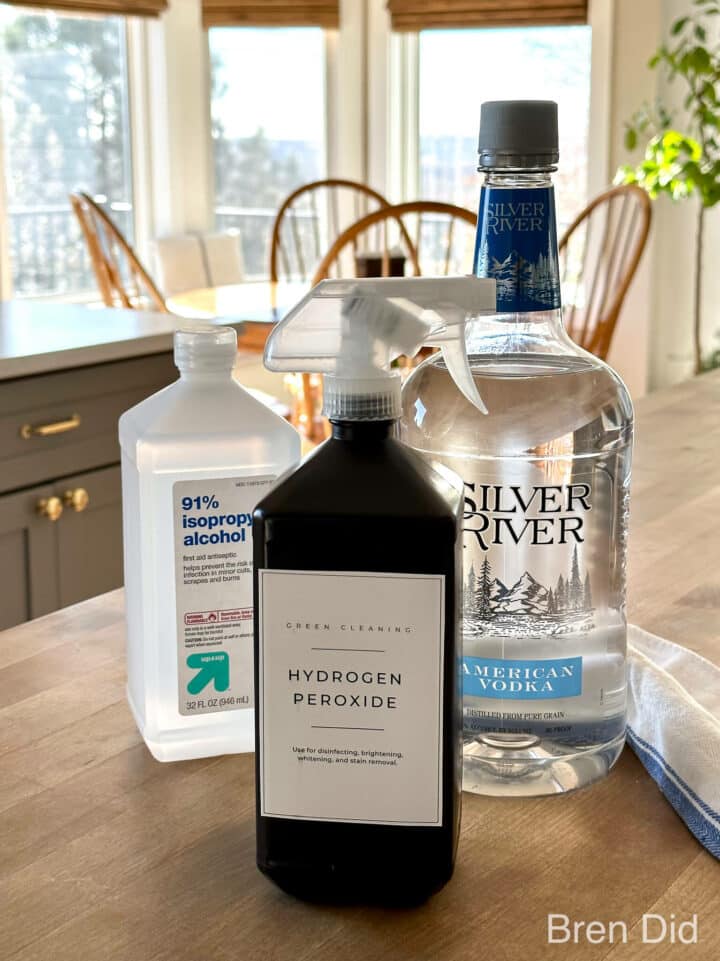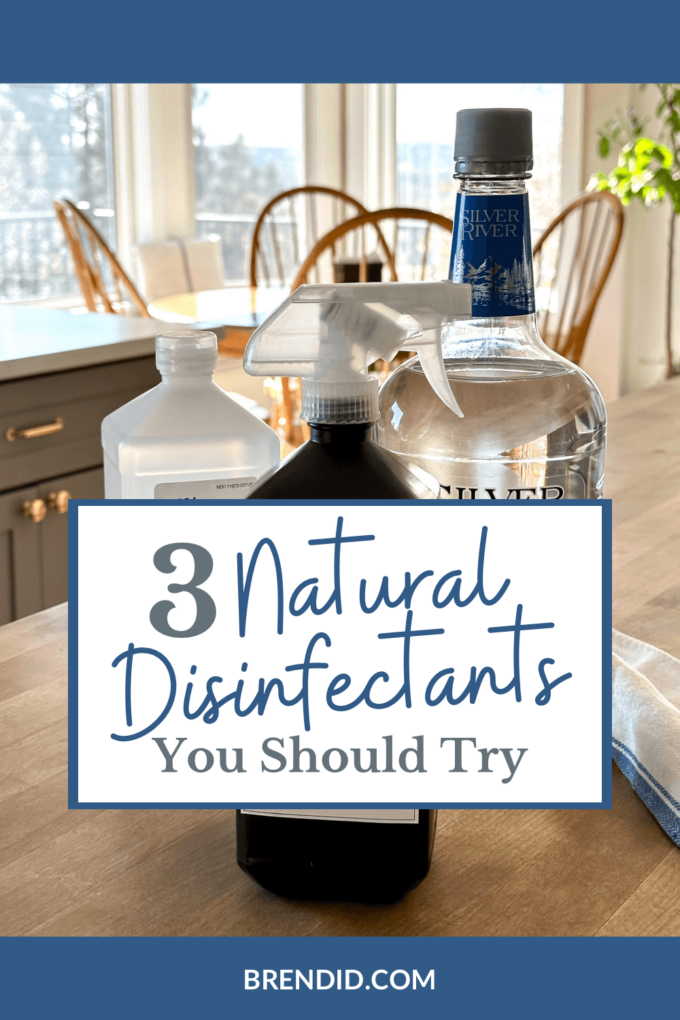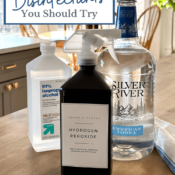Discover 3 natural ingredients that can be used as effective disinfectants for your home. Say goodbye to toxic chemicals and hello to a more eco-friendly cleaning routine.

During cold and flu season, you may find yourself wanting to disinfect doorknobs and bathrooms, especially when a family member is sick. Or, after handling raw meat, you may feel the urge to disinfect potentially contaminated kitchen counters to minimize the risk of foodborne illnesses.
In the past, these scenarios would send me running to grab the disinfectant cleaners to “keep everyone healthy.” However, once I started researching and writing about natural cleaning products, I learned that routine disinfecting isn’t really necessary and can even cause problems.
In this article, we’ll take a closer look at disinfectants: three natural ones you may already have at home, when you should use them, and why.
Do I need to disinfect?
The truth is that routine disinfection is rarely needed in most households. Cleaning surfaces with soap or detergent and water removes most of the germs, dirt, and other impurities. If done correctly, the EPA says cleaning can remove 98% of bacteria and 93% of viruses that can make us sick.
Disinfectants help kill germs only after a surface is cleaned. They break down the cells of viruses and bacteria when they are left on the surface for the correct amount of time. This “dwell time” is the amount of time the disinfectant must be left wet on a surface.
In short, cleaners do not kill germs; they help remove them. Disinfectants do not remove dirt or grime from a surface; they kill them.
How are disinfectant cleaners tested?
Many people mistakenly think that if a disinfecting product is sold to the public, it has been tested, reviewed, and proven safe by a government agency.
This is not true.
The U.S. Environmental Protection Agency (EPA) regulates sanitizers and disinfectants as pesticides. They require products labeled as sanitizers or disinfectants to kill the germs they claim to kill, but they do not evaluate products for possible health risks.
Are disinfectant cleaners safe?
To some degree, all disinfecting chemicals are toxic. Disinfectants kill bacteria and viruses, but they also have health risks.
Some of the chemicals used in these products affect air quality and can cause or trigger health problems such as asthma or cancer.
- For example, 11% of people with work-related asthma in California connected their asthma to cleaning and disinfecting products. Over half of these patients never had asthma before being exposed to the products – inhaling the products caused their asthma.
- Four out of the 5 people diagnosed with work-related asthma in this study were bystanders. They were not working directly with cleaning or disinfecting chemicals. They were simply nearby and exposed to them.
- In the US, researchers estimate that 5% of childhood cancer and 30% of childhood asthma are related to chemical exposures.
Weighing the Risks vs. the Benefits
In the past, disinfecting cleaners were seen as the best way to prevent the spread of infectious diseases, but little thought was given to their health risks.
Today, we know it’s important to weigh the health risks of exposure to disinfection chemicals to the health risks of the infectious diseases they are intended to prevent.
Choosing less hazardous disinfecting products can reduce harmful health effects. They are also better for the environment.
What are the safest disinfectants?
The EPA Design for the Environment Antimicrobial Product Program has a list of disinfection products that use active ingredients that are safer for human health and the environment. These active ingredients include 3 of my favorite “green” disinfectants: hydrogen peroxide, vodka (ethanol), and rubbing alcohol (isopropyl alcohol).
Hydrogen Peroxide
Hydrogen peroxide is water (H2O) with an extra oxygen molecule (H2O2). It is an environment-friendly disinfectant that kills germs and can also be used to bleach or lighten surfaces.
According to the CDC, “Commercially available 3% hydrogen peroxide is a stable and effective disinfectant”. Plus, hydrogen peroxide breaks down quickly into water and oxygen, leaving no dangerous residue behind.
Note: Always keep hydrogen peroxide in the original opaque bottle. It breaks down in light or when stored in a light-colored spray bottle. (See how I use hydrogen peroxide here.)
Vodka / Grain Alcohol / Ethanol
Ethanol (ethyl alcohol) is the type of alcohol in beer, wine, and other alcoholic beverages. Vodka is a solution of ethanol and water. It is usually 80-100 proof (40–50% ethanol). Grain alcohol is a solution of ethanol and water. It contains approximately twice as much ethanol as traditional distilled spirits, usually 100 to 190 proof (50-80% ethanol).
Note: Flavored liquors add various compounds or extracts; I do not recommend flavored vodka for cleaning.
Rubbing Alcohol / Isopropanol
Rubbing alcohol is usually a solution of isopropanol (isopropyl alcohol) and water. It is usually 70 or 91% alcohol.
Some rubbing alcohols are made from denatured alcohol (ethyl alcohol with toxic or bad-tasting additives that make it unsuitable for consumption).
Note: Rubbing alcohol can contain wintergreen, methyl salicylate, dyes, or other additives. These versions should not be used for cleaning.
Which alcohol is better to clean & disinfect?
The amount of alcohol in the solution is what makes vodka or rubbing alcohol a disinfectant, so the higher the percentage of alcohol, the better the disinfectant. According to the EPA, 70% of alcohol solutions are effective disinfectants.
I prefer to use vodka or grain alcohol for cleaning for three reasons:
- Rubbing alcohol has a strong, unpleasant odor that lingers. Make sure it is used in a well-ventilated area.
- Rubbing alcohol is highly flammable and can damage wood and paint. Make sure it is used only on glass or other sturdy surfaces.
- Vodka is safe for human consumption. I do not recommend drinking your cleaning alcohol, but I prefer using one that is safe for human consumption in reasonable amounts.
How to Disinfect
Studies of disinfectant cleaners show that many of us are using the products incorrectly. To effectively disinfect, you should follow these steps:
- Clean the surface of all visible dirt and debris. (For a disinfectant to work, it has to touch the bacteria. Dirt and grime can protect the germs you’re trying to kill.)
- Apply disinfectant and allow it to dwell for several minutes. (Many of us give surfaces a quick spray and then wipe. To allow any disinfectant to work, the cleaner must stay wet on the surface anywhere from 30 seconds to 10 minutes.)
- Allow the area to air dry, then rinse. (The American Cleaning Institute, a cleaning product industry group, recommends letting surfaces treated with disinfectant air dry, then rinsing surfaces that come into contact with human skin with water.)
Should you disinfect just to “be safe”?
Routine disinfecting – disinfecting on a regular basis after cleaning – is not necessary in most households. It’s better to adopt a targeted approach and save disinfection for when it’s needed.
A quick way to remember when to disinfect is the phrase, “incidents and outbreaks:”
- Treating areas after cleaning up “incidents” of human fluids.
- Treat high-touch surfaces (door handles, remotes) or bathrooms (toilet, sinks) during “outbreaks” of contagious illnesses or viruses.
*You should also disinfect more frequently if you live with immunocompromised individuals.
The Risks of Overuse
Resist the urge to disinfect regularly because overusing disinfectants can lead to other problems:
- Overusing disinfectant chemicals contributes to the growing problem of antibiotic-resistant bacteria, more commonly known as “superbugs.”
- Studies have shown that a significant number of consumer misuse disinfectant cleaners in ways that can negatively affect their health.
What natural cleaners are not disinfectants?
Several natural cleaners, like vinegar and essential oils, are frequently misidentified as natural disinfectants. While these substances are useful for general cleaning purposes, they do not eliminate enough germs and bacteria to meet the criteria for EPA-registered disinfectants. To be legally classified as a disinfectant, a product must be capable of killing 99.999 percent of bacteria or viruses within five to 10 minutes of application. The Environmental Protection Agency regulates these products in the United States and maintains a list of registered disinfectants that can successfully kill a variety of pathogens, including the virus that causes COVID-19.
Vinegar
Vinegar is commonly referred to as a natural disinfectant, and while it has some disinfectant properties, it is not as effective as alcohol or hydrogen peroxide at killing pathogens. Acetic acid, the main ingredient in vinegar, does help remove dirt and reduce bacteria on dirty surfaces. However, a 10% vinegar solution is necessary to reduce the viability of the flu virus and kill bacteria that cause tuberculosis. The white vinegar typically used for cleaning is about 4% to 7% acetic acid,
Learn more about cleaning with vinegar here.
Essential Oils
Some essential oils, like tea tree, clove, and cinnamon, may kill certain strains of viruses and bacteria, but they are not as effective as alcohol or hydrogen peroxide on a wide range of pathogens. Scientific research into essential oils is limited; more is needed to determine if essential oils are capable of killing 99.999 percent of bacteria or viruses.
- One study found that diffused thieves oil (a blend of cinnamon, clove, eucalyptus, rosemary, and lemon essential oil) lowered the airborne levels of three types of bacteria but did not reach the threshold needed to be classified as a disinfectant.
- Studies of tea tree oil show that it has antimicrobial and anti-inflammatory properties but lacks clinical evidence demonstrating its effectiveness against bacteria, fungi, and viruses.
Learn more about cleaning with essential oils here.
Here’s the bottom line…
Natural disinfectants such as hydrogen peroxide, vodka or grain alcohol (ethanol), and rubbing alcohol (isopropyl alcohol) are safer for human health and the environment compared to conventional chemical disinfectants such as chlorine bleach. Always follow the correct method of disinfection: cleaning the surface, applying the disinfectant, allowing the recommended dwell time, and then rinsing or air drying. Remember, most households rarely need disinfection since germs and bacteria are removed through routine cleaning.
FAQ
Natural disinfectants include hydrogen peroxide, vodka (ethanol), and rubbing alcohol (isopropyl alcohol). These ingredients effectively kill germs and are safer for human health and the environment than conventional chemical disinfectants.
The safest way to disinfect is to use natural disinfectants such as hydrogen peroxide, vodka (ethanol), and rubbing alcohol (isopropyl alcohol). These ingredients are safer for human health and the environment compared to conventional chemical disinfectants. Always follow the correct method of disinfection, which includes cleaning the surface first, applying the disinfectant, allowing it to dwell for the recommended time, and then rinsing or allowing the area to air dry. Remember that routine disinfection is rarely needed in most households.
While essential oils are often marketed as natural disinfectants, and some (such as tea tree oil) have proven antibacterial qualities, there is limited scientific evidence to support their effectiveness as broad-spectrum disinfectants. It’s important to rely on scientifically proven and tested natural disinfectants such as hydrogen peroxide, vodka (ethanol), and rubbing alcohol (isopropyl alcohol) for more reliable disinfection.
An easy DIY disinfectant spray can be made by screwing a spray top onto a bottle of hydrogen peroxide, vodka or grain alcohol (ethanol), or rubbing alcohol (isopropyl alcohol). These natural disinfectants are effective and safer for human health and the environment compared to conventional chemical disinfectants. Always follow the correct method of disinfection, which includes cleaning the surface first, applying the disinfectant, allowing it to dwell for the recommended time, and then rinsing or allowing the area to air dry. Remember that routine disinfection is rarely needed in most households.

Article Sources
- What’s the difference between products that disinfect, sanitize, & clean surfaces?, EPA
- A Rational Approach to Disinfection and Sterilization, CDC
- What are the Risks of CLeaning with Bleach and Other Disinfectants, New York Times
- Safer Disinfectant Use, Western States Pediatric Environmental Health Specialty Unit
- DfE-Certified Disinfectants, EPA
- Are You Over-Disinfecting Your Home?, Apartment Therapy




Leave a Reply